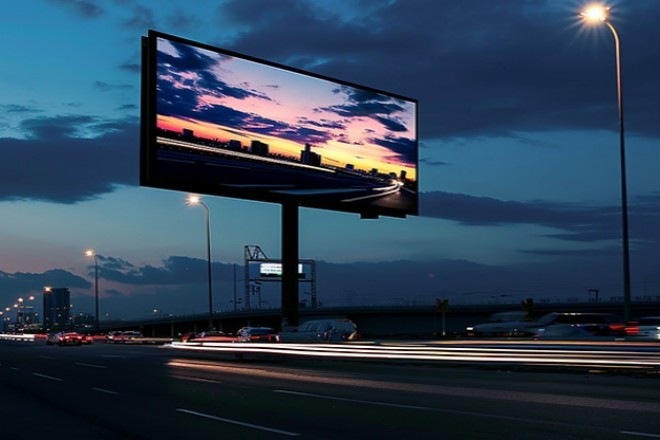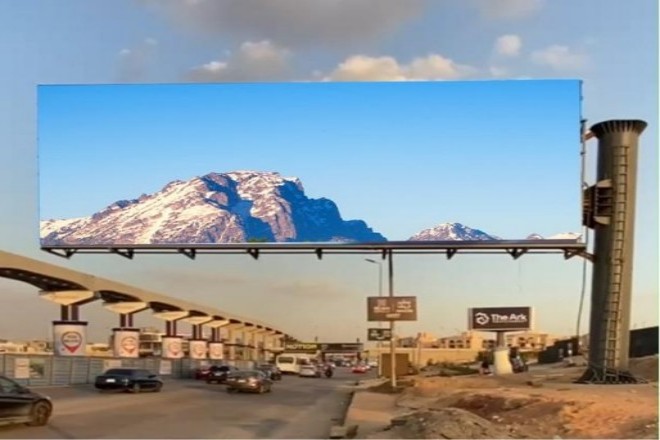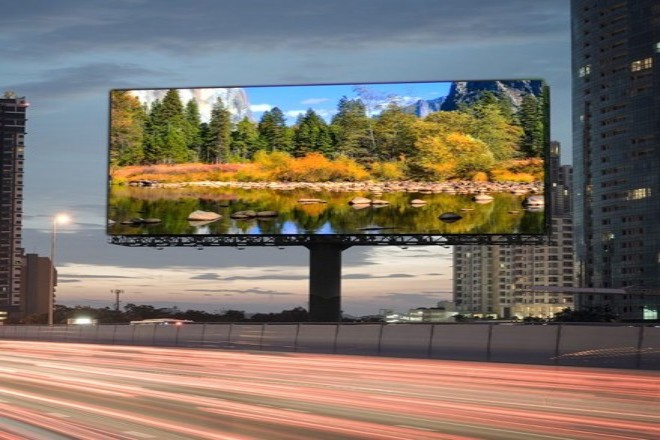介绍

Have you ever seen the LED screens next to you when you are driving on the highway? Or do you look at the LED advertising screens on the highway when you are passing by in a vehicle?
In fact, compared with LED屏幕 in cities, the exposure rate of LED screens installed on highways is lower, so how can we ensure the exposure rate of LED screens installed on highways?
Method 1: Accurately locate the location of the LED screen

1). Pick a “golden location”
First, you have to be like a shrewd businessman and pick a good place with heavy traffic. This is not a random choice; you have to show the data:
- Traffic flow survey:
You have to see which section of the road has the most cars, especially those places with heavy traffic during peak hours in the morning and evening.
But you also have to pay attention to the fact that the speed is too fast or too slow, and you have to find a “just right” speed range so that drivers can see the screen clearly without affecting driving safety because of watching the screen.
- Vehicle type analysis:
You have to think about it. Are there more small cars, large trucks, and buses running on this road? The driver’s sight height is different for different models, so the position of the LED screen should be adjusted accordingly.
2). Make the screen “bright” in front of the driver
Next, we have to ensure that the LED screen can properly enter the driver’s sight range and not be blocked by any trees or buildings.
- 实地调查:
You have to go to the site in person to see what the driver’s sight is like at different times and in different weather. Especially on rainy days or in the evening, the light is not good, and the screen must be bright enough.
- Avoid obstruction:
The front of the LED screen should be open and there should be nothing blocking it. Sometimes, even billboards and signboards on the roadside may become “roadblocks”, so you have to plan carefully.
3). The angle and height must be just right
Finally, the installation angle and height of the LED screen are technical jobs that require attention:
- 角度调整:
The LED screen should be slightly tilted to form a “friendly” angle with the driver’s sight. This will not make the driver feel dazzling and ensure that the information is clear at a glance.
- Height setting:
The LED screen should not be too high or too low. If it is too high, the driver will have to look up and be easily distracted; if it is too low, it may be blocked by the car body. You have to find a height that can avoid being blocked by the car and allow the driver to see it easily.
4). Tips
- Compliance:
Don’t forget to say hello to the transportation, planning, and other departments to ensure that your installation plan is legal and compliant.
- 维护方便:
After the LED screen is installed, subsequent maintenance is also very important. You have to choose a location that is convenient for maintenance, so that you don’t have to make a big move to repair the screen.
Method 2: Optimize LED display content to increase attractiveness
Optimizing the display content is a key step in making the LED display screen on the highway attract drivers’ attention. Let’s talk about how to make the information on this screen both eye-catching and accurately convey the key points.
1). The content should be concise and grasp the key points at a glance
It is not easy for drivers to do two things at the same time when driving on the highway, so our information must be concise, clear, and to the point.
Concise text: Don’t talk too much. Just make things clear in a few sentences. Enlarge and bold the key information so that the driver can scan it at a glance.
Icon assistance: Don’t use text if you can use icons to represent it. For example, gas stations, restaurants, and rest areas can all be represented by an icon, which is intuitive and convenient.
2). The colors should be bright, and dynamic effects should be used to add points
On the highway, drivers’ attention is scattered, so we have to use some “little tricks” to attract their attention.
High contrast colors: Choose those contrasting colors, such as red and green, black and white, to ensure that they can be seen at a glance from a distance.
动态效果: Don’t always keep the same. Add some flashing, scrolling, and gradient animations to make the screen come alive, but don’t go too far to avoid distracting the driver’s attention.
3). The content should be considerate, different for different people, and different for different times
Different drivers have different needs at different times. We have to be a “conscientious little cotton jacket”.
Audience analysis: Long-distance drivers may be more concerned about road conditions and gas stations; short-distance drivers may want to see what delicious food is nearby. Adjust the content according to the audience so that they feel “this information is useful to me.”
Time adjustment: In the morning rush hour, you may have to remind drivers to drive safely; in the evening, you have to tell them where to stay. With time, the content must also be updated.
4). Tips
Test feedback: Before launching new content, find a small area to test it to see how drivers react, and then adjust it based on feedback.
更新频率: Don’t change the content for too long, but don’t change it too often. Find a suitable update rhythm so that drivers will feel fresh every time they pass by, but they won’t feel dazzled.
Method 3: Improve the technical performance of LED display screens

- 高的 亮度 和高对比度:
If you drive on the highway on a sunny day, if the LED display screen on the side of the road is as dim as a small light bulb, you will definitely find it difficult to see the content displayed on it, right?
Therefore, the high-speed LED display screen must be very bright, with a brightness of at least 5000 nits, so that it can be seen clearly even under the sun. Moreover, contrast is also very important.
It is like adding a “three-dimensional sense” to the picture, making the text and images more prominent so that even if you are driving fast, you can notice the content on the display at a glance.
Did you know? Just like mobile phone screens, LED displays also have resolution and pixel pitch. The higher the resolution, the finer the picture and the more comfortable it looks.
For LED displays on highways, we recommend choosing a pixel pitch of P6 or smaller so that even if you are far away or driving fast, you can see every detail on the screen.
Of course, the specific pixel pitch you choose depends on the actual installation location and the distance between the audience and the screen.
- 宽的 可视角度 technology:
Imagine that you are sitting in a car, and sometimes you may look at the LED display on the roadside from an angle. If the screen can only be seen clearly from the front, it will be troublesome.
Therefore, high-speed LED displays must use wide viewing angle technology so that no matter which angle you look at them from, you can get a clear visual effect. This is a big plus for highway passengers, who often change their perspective!
Method 4: Use smart technology to improve the exposure efficiency of LED display screens
In this digital age, you have to make LED display screens more “smart” so that they can run faster and farther on the road of information dissemination.
Next, let’s talk about how to use smart technology to make LED display screens a little expert in information dissemination.
1). Vehicle identification + intelligent control, content changes as you like
If the LED display screen can “see” the passing vehicles and then automatically adjust the displayed content according to the type and speed of the vehicle, how interesting it would be!
For example, when a sports car whizzes by, the display screen will quickly flash a reminder: “Safety first, don’t go too fast!” if you encounter a slow tourist bus, then change it to a detailed introduction of “Nearby attractions are released, don’t miss it!”
All of this depends on the perfect cooperation of vehicle identification technology and intelligent control systems. Vehicle identification technology is responsible for “seeing,” and intelligent control systems are responsible for “thinking” and “doing.”
Once the two work together, the LED display screen can display the most appropriate content according to different vehicles!
2). Big data analysis makes the content understand you better
Did you know? Big data analysis is a treasure. It can help us predict the future and make the content of LED display screens closer to the hearts of the audience. By analyzing historical traffic data, we can roughly know when there are many cars on the road and when there are few cars.
The LED display screen will display some urgent and important information based on this “weather forecast” when there are many cars, such as “Congestion ahead, take a detour!”; when there are few cars, it will relax and show some promotional, entertainment and other content to make everyone happy.
Moreover, big data analysis can also tell us what the audience likes, so the LED display screen will cater to their preferences and push some content that everyone likes to watch. Isn’t this a happy ending?
3). Remote control makes management easy
In the past, managing LED display screens required running on-site, which was time-consuming and laborious. Now, with remote control systems, everything has become much simpler.
The operator can sit in the office and adjust the brightness and contrast of the display screen with the mouse and can even remotely update the content and detect faults. In the event of bad weather or emergencies, it can also respond quickly, issue relevant notifications, and guide vehicles to drive safely.
In this way, managers can easily handle multiple display screens, and efficiency will naturally increase.
Method 5: Integration with other traffic information systems

Integrating LED display screens with other traffic information systems can significantly improve the breadth and depth of its information services and provide travelers with more comprehensive and real-time traffic information. The following are two specific integration methods:
1). Integrate with highway traffic information systems
- Real-time traffic information:
LED display screens can be connected to highway traffic information systems to obtain and display current traffic information in real-time, such as road congestion, traffic accidents, construction closures, etc. This helps drivers plan routes in advance, avoid congestion, and improve travel efficiency.
- Weather warning information:
In severe weather conditions, such as heavy rain, heavy snow, and heavy fog, LED display screens can issue weather warning information in real time to remind drivers to drive safely and take necessary precautions. This helps reduce the occurrence of traffic accidents and ensure driving safety.
- Comprehensive information services:
By integrating highway traffic information systems and other relevant data sources, LED display screens can also provide comprehensive information services, such as location information of nearby gas stations, service areas, parking lots, and emergency rescue telephone numbers.
These services can provide drivers with a more convenient and considerate travel experience.
2). Use multiple channels to promote the location and content of the display screen
Traffic broadcast promotion: Cooperate with traffic broadcast to regularly promote the location and content of the LED display screen in the broadcast.
Through the wide coverage of the broadcast, more drivers can be informed of the existence of the display screen and the services provided, and the visibility and usage rate of the display screen can be improved.
- Navigation system integration:
Cooperate with mainstream navigation systems to integrate the location and content of the LED display screen into the navigation system.
In this way, when drivers use the navigation system for route planning, they can intuitively see the location of the display screen and the information content displayed, so as to obtain the required traffic information more conveniently.
- Social media promotion:
Use social media platforms such as INS and YouTube to publish relevant information and exciting content on the LED display screen. Through the dissemination effect of social media, the visibility and influence of the display screen can be quickly expanded, attracting more drivers’ attention and use.
结论
In short, through carefully planned installation locations, attractive content design, advanced technical support, intelligent operation strategies, and meticulous maintenance management, we can significantly improve the exposure rate of highway LED display screens so that information can be accurately transmitted while vehicles are galloping.
最后,如果你想了解更多关于LED显示屏的信息, 请与我们联系。
